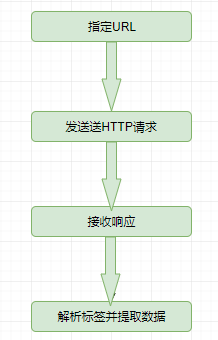
作者 | HelloGitHub-秦人
來源 | HelloGitHub(ID:GitHub520)
HelloGitHub 推出的《講解開源項目》系列,今天給大家?guī)硪豢铋_源 JAVA 版一款網(wǎng)頁元素解析框架——jsoup,通過程序自動獲取網(wǎng)頁數(shù)據(jù)。
項目源碼地址:https://github.com/jhy/jsoup

項目介紹
jsoup 是一款 Java 的 html 解析器。可直接解析某個 URL 地址的 HTML 文本內(nèi)容。它提供了一套很省力的 API,可通過 DOM、css 以及類似于 jQuery 選擇器的操作方法來取出和操作數(shù)據(jù)。
jsoup 主要功能:
-
從一個 URL、文件或字符串中解析 HTML。
-
使用 DOM 或 CSS 選擇器來查找、取出數(shù)據(jù)。
-
可操作 HTML 元素、屬性、文本。

使用框架
2.1 準(zhǔn)備工作
-
掌握 HTML 語法
-
Chrome 瀏覽器調(diào)試技巧
-
掌握開發(fā)工具 idea 的基本操作
2.2 學(xué)習(xí)源碼
將項目導(dǎo)入 idea 開發(fā)工具,會自動下載 maven 項目需要的依賴。源碼的項目結(jié)構(gòu)如下:

快速學(xué)習(xí)源碼是每個程序員必備的技能,我總結(jié)了以下幾點:
-
閱讀項目 ReadMe 文件,可以快速知道項目是做什么的。
-
概覽項目 pom.xml 文件,了解項目引用了哪些依賴。
-
查看項目結(jié)構(gòu)、源碼目錄、測試用例目錄,好的項目結(jié)構(gòu)清晰,層次明確。
-
運行測試用例,快速體驗項目。
2.3 下載項目
git clone https://github.com/jhy/jsoup
2.4 運行項目測試代碼
通過上面的方法,我們很快可知 example 目錄是測試代碼,那我們直接來運行。注:有些測試代碼需要稍微改造一下才可以運行。
例如,jsoup 的 Wikipedia 測試代碼:
public class Wikipedia {
public static void main(String[] args) throws IOException {
Document doc = Jsoup.connect("http://en.wikipedia.org/").get;
log(doc.title);
Elements newsHeadlines = doc.select("#mp-itn b a");
for (Element headline : newsHeadlines) {
log("%snt%s", headline.attr("title"), headline.absUrl("href"));
}
}
private static void log(String msg, String... vals) {
System.out.println(String.format(msg, vals));
}
}
說明:上面代碼是獲取頁面(http://en.wikipedia.org/)包含(#mp-itn b a)選擇器的所有元素,并打印這些元素的 title , herf 屬性。維基百科 國內(nèi)無法訪問,所以上面這段代碼運行會報錯。
改造后可運行的代碼如下:
public static void main(String[] args) throws IOException {
Document doc = Jsoup.connect("https://www.baidu.com/").get;
Elements newsHeadlines = doc.select("a[href]");
for (Element headline : newsHeadlines) {
System.out.println("href: " +headline.absUrl("href") );
}
}

工作原理
Jsoup 的工作原理,首先需要指定一個 URL,框架發(fā)送 HTTP 請求,然后獲取響應(yīng)頁面內(nèi)容,然后通過各種選擇器獲取頁面數(shù)據(jù)。整個工作流程如下圖:

以上面為例:
3.1 發(fā)請求
Document doc = Jsoup.connect("https://www.baidu.com/").get;
這行代碼就是發(fā)送 HTTP 請求,并獲取頁面響應(yīng)數(shù)據(jù)。
3.2 數(shù)據(jù)篩選
Elements newsHeadlines = doc.select("a[href]");
定義選擇器,獲取匹配選擇器的數(shù)據(jù)。
3.3 數(shù)據(jù)處理
for (Element headline : newsHeadlines) {
System.out.println("href: " +headline.absUrl("href") );
}
這里對數(shù)據(jù)只做了一個簡單的數(shù)據(jù)打印,當(dāng)然這些數(shù)據(jù)可寫入文件或數(shù)據(jù)的。

實戰(zhàn)
獲取豆瓣讀書 -> 新書速遞中每本新書的基本信息。包括:書名、書圖片鏈接、作者、內(nèi)容簡介(詳情頁面)、作者簡介(詳情頁面)、當(dāng)當(dāng)網(wǎng)書的價格(詳情頁面),最后將獲取的數(shù)據(jù)保存到 Excel 文件。
目標(biāo)鏈接:https://book.douban.com/latest?icn=index-latestbook-all
4.1 項目 pom.xml 文件
項目引入 jsoup、lombok、easyexcel 三個庫。
<?xml version="1.0" encoding="UTF-8"?>
<project xmlns="http://maven.Apache.org/POM/4.0.0"
xmlns:xsi="http://www.w3.org/2001/XMLSchema-instance"
xsi:schemaLocation="http://maven.apache.org/POM/4.0.0 http://maven.apache.org/xsd/maven-4.0.0.xsd">
<modelVersion>4.0.0</modelVersion>
<groupId>org.example</groupId>
<artifactId>JsoupTest</artifactId>
<version>1.0-SNAPSHOT</version>
<properties>
<maven.compiler.target>1.8</maven.compiler.target>
<maven.compiler.source>1.8</maven.compiler.source>
</properties>
<dependencies>
<dependency>
<groupId>org.jsoup</groupId>
<artifactId>jsoup</artifactId>
<version>1.13.1</version>
</dependency>
<dependency>
<groupId>org.projectlombok</groupId>
<artifactId>lombok</artifactId>
<version>1.18.12</version>
</dependency>
<dependency>
<groupId>com.alibaba</groupId>
<artifactId>easyexcel</artifactId>
<version>2.2.6</version>
</dependency>
</dependencies>
</project>
4.2 解析頁面數(shù)據(jù)
public class BookInfoUtils {
public static List<BookEntity> getBookInfoList(String url) throws IOException {
List<BookEntity> bookEntities=new ArrayList<>;
Document doc = Jsoup.connect(url).get;
Elements liDiv = doc.select("#content > div > div.article > ul > li");
for (Element li : liDiv) {
Elements urls = li.select("a[href]");
Elements imgUrl = li.select("a > img");
Elements bookName = li.select(" div > h2 > a");
Elements starsCount = li.select(" div > p.rating > span.font-small.color-lightgray");
Elements author = li.select("div > p.color-gray");
Elements description = li.select(" div > p.detail");
String bookDetailUrl = urls.get(0).attr("href");
BookDetailInfo detailInfo = getDetailInfo(bookDetailUrl);
BookEntity bookEntity = BookEntity.builder
.detailPageUrl(bookDetailUrl)
.bookImgUrl(imgUrl.attr("src"))
.bookName(bookName.html)
.starsCount(starsCount.html)
.author(author.text)
.bookDetailInfo(detailInfo)
.description(description.html)
.build;
// System.out.println(bookEntity);
bookEntities.add(bookEntity);
}
return bookEntities;
}
/**
*
* @param detailUrl
* @return
* @throws IOException
*/
public static BookDetailInfo getDetailInfo(String detailUrl)throws IOException{
Document doc = Jsoup.connect(detailUrl).get;
Elements content = doc.select("body");
Elements price = content.select("#buyinfo-printed > ul.bs.current-version-list > li:nth-child(2) > div.cell.price-btn-wrApper > div.cell.impression_track_mod_buyinfo > div.cell.price-wrapper > a > span");
Elements author = content.select("#info > span:nth-child(1) > a");
BookDetailInfo bookDetailInfo = BookDetailInfo.builder
.author(author.html)
.authorUrl(author.attr("href"))
.price(price.html)
.build;
return bookDetailInfo;
}
}
這里的重點是要獲取網(wǎng)頁對應(yīng)元素的選擇器。
例如:獲取 li.select("div > p.color-gray") 中 div > p.color-gray 是怎么知道的。
使用 chrome 的小伙伴應(yīng)該都猜到了。打開 chrome 瀏覽器 Debug 模式,Ctrl + Shift +C 選擇一個元素,然后在 html 右鍵選擇 Copy ->Copy selector,這樣就可以獲取當(dāng)前元素的選擇器。如下圖:

4.3 存儲數(shù)據(jù)到 Excel
為了數(shù)據(jù)更好查看,我將通過 jsoup 抓取的數(shù)據(jù)存儲的 Excel 文件,這里我使用的 easyexcel 快速生成 Excel 文件。
Excel 表頭信息
@Data
@Builder
public class ColumnData {
@ExcelProperty("書名稱")
private String bookName;
@ExcelProperty("評分")
private String starsCount;
@ExcelProperty("作者")
private String author;
@ExcelProperty("封面圖片")
private String bookImgUrl;
@ExcelProperty("簡介")
private String description;
@ExcelProperty("單價")
private String price;
}
生成 Excel 文件
public class EasyExcelUtils {
public static void simpleWrite(List<BookEntity> bookEntityList) {
String fileName = "D:\devEnv\JsoupTest\bookList" + System.currentTimeMillis + ".xlsx";
EasyExcel.write(fileName, ColumnData.class).sheet("書本詳情").doWrite(data(bookEntityList));
System.out.println("excel文件生成完畢...");
}
private static List<ColumnData> data(List<BookEntity> bookEntityList) {
List<ColumnData> list = new ArrayList<>;
bookEntityList.forEach(b -> {
ColumnData data = ColumnData.builder
.bookName(b.getBookName)
.starsCount(b.getStarsCount)
.author(b.getBookDetailInfo.getAuthor)
.bookImgUrl(b.getBookImgUrl)
.description(b.getDescription)
.price(b.getBookDetailInfo.getPrice)
.build;
list.add(data);
});
return list;
}
}
4.4 最終展示效果
最終的效果如下圖:

以上就是從想法到實踐,我們就在實戰(zhàn)中使用了 jsoup 的基本操作。
完整代碼地址:https://github.com/hellowHuaairen/JsoupTest

最后
Java HTML Parser 庫:jsoup,把它當(dāng)成簡單的爬蟲用起來還是很方便的吧?
為什么會講爬蟲?大數(shù)據(jù),人工智能時代玩的就是數(shù)據(jù),數(shù)據(jù)很重要。作為懂點技術(shù)的我們,也需要掌握一種獲取網(wǎng)絡(luò)數(shù)據(jù)的技能。當(dāng)然也有一些工具 Fiddler、webscraper 等也可以抓取你想要的數(shù)據(jù)。
教程至此,你應(yīng)該也能對 jsoup 有一些感覺了吧。編程是不是也特別有意思呢?參考我上面的實戰(zhàn)案例,有好多網(wǎng)站可以實踐一下啦~






